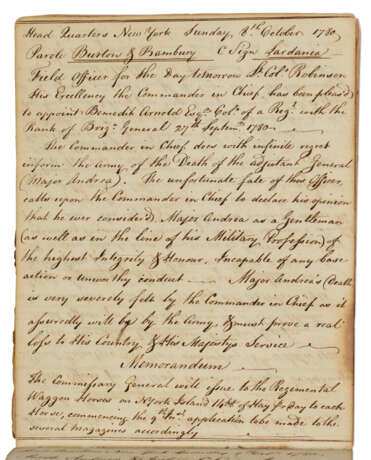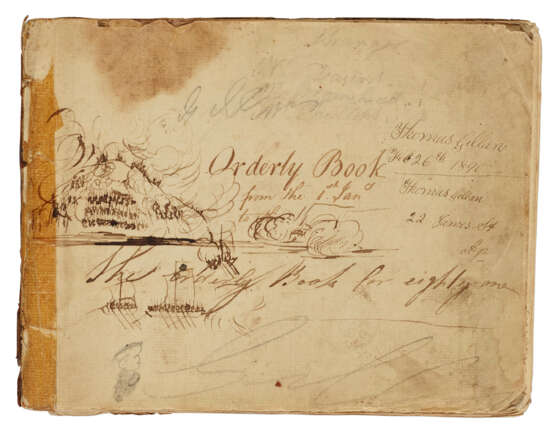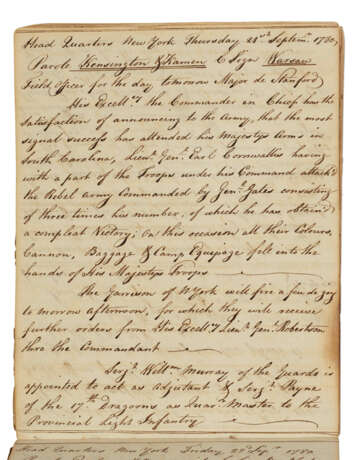ID 887929
Lot 151 | Recording Arnold's treason and André execution
Estimate value
$ 15 000 – 25 000
168 pages, 193 x 150mm (occasional soiling and losses). Contemporary marbled boards (front board lacking, spine cracked, several pages loose).
An important orderly book from the British garrison in New York during the campaign of 1780 covering Benedict Arnold's appointment as Brigadier General, John André's execution, the Battle of Springfield, as well as Cornwallis' victories in the South. Like most orderly books, each entry begins with the countersign and parole, the officers of the day, followed by the general orders. Of particular interest that cover Arnold's treason and André's execution as a spy. Indeed André's name appears twice in the orderly book. On 28 August, we learn of his appointment as "Adjutant Genl of the Army under his command." Then on 8 October, General Clinton notes André's execution immediately after announcing that he was "pleas'd to appoint Benedict Arnold Esqr Col. Of the Regt with a rank of Briga General 27th September 1780," and then adding, "The commander in Chief does with infinite regret inform the army of the death of the adjutant general (Major Andrea [sic]). The unfortunate fate of this officer, calls upon the commander in chief to declare his opinion that he ever consider'd Major Andrea as a Gentleman (as well as in the line of his military profession) of the highest integrity & honor, incapable of any base action or unworthy conduct. Major Andrea's death is very severely felt by the commander in chief as it assuredly will be by the army, & must prove a real loss to his country & his Majesty's service." André's execution at Tappan proved just as troubling to many Continental officers as well, but in Washington's interpretation of the rules of war, the British major had been caught in plain clothes and had to be considered a spy—for which the customary punishment was by hanging. Arnold, in his new capacity, led raids in Virginia and later mounted a devastating attack on New London, Connecticut, burning most of the town on 4 September 1781.
The orderly book additionally covers other major events of the 1780 campaign, most notably the British victories in the South—welcome news to the garrison considering that the situation in and around New York had been largely a stalemate since late 1778. On 29 May, "General Knyphausen," who had been commanding the garrison in the absence of General Henry Clinton, who was then leading British forces in South Carolina and Georgia, notes the capture of Charleston, in which "the rebels have lost their whole army and fleet in that part of the continent." Closer to home, the book notes minor skirmishes along the lines that divided British-controlled New York from the American positions in New Jersey and Westchester. On 18 April, Knyphausen asks that "his thanks may be given in public orders, to Major de Boye of the Hessian Regt of Boes, for his good conduct in attacking & forcing a body of Rebels, canton'd in Hoppers Town in Jersey upon the morning of the 16th Inst." The general took particular notice of the cavalry "for their determin'd attack upon the different houses possessed by the rebels a that place…" The book also offers insights into daily life, and the means by which bored soldiers amused themselves, most notably "Robbing and plundering," which had "grown so prevalent a custom as to cause the greatest complains upon every occasion…" To remedy the situation, on 6 June, the general ordered that anyone "apprehended of committing the least excess of this kind in taking or plundering from any person or persons whatever shall be hang'd without mercy & the regiment or corps, to which such transgression belong shall pay the value of the stolen goods on the spot." The orderly book's cover has been decorated with doodles including a drawing of ships and of troops ascending a hill. In all, the book offers a valuable picture of daily life in the British garrison in New York in the later stages of the American Revolutionary War.
| Place of origin: | USA |
|---|---|
| Auction house category: | Letters, documents and manuscripts |
| Place of origin: | USA |
|---|---|
| Auction house category: | Letters, documents and manuscripts |
| Address of auction |
CHRISTIE'S 8 King Street, St. James's SW1Y 6QT London United Kingdom | |
|---|---|---|
| Preview |
| |
| Phone | +44 (0)20 7839 9060 | |
| Buyer Premium | see on Website | |
| Conditions of purchase | Conditions of purchase |






